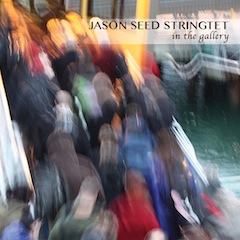
Jason Seed Stringtet: ‘…it’s folk music that comes not from a formal geographic or cultural area, but from my own brain,’ says Jason Seed (far left).
“Learn what you can, then get out of your own way and create!”
Or so exclaims Jason Seed, composer and guitarist, whose work might quote Black Sabbath or Bill Frisell in the middle of a Piazzolla-inspired near-tango (“Tangoesque”), who can win an Independent Music Award in the Jam Band category and write pieces for major U.S. symphonies to celebrate Eastern European composers. With a background in jazz (one of his mentors was trombonist and symphonic jazz composer David Baker), Seed has turned his hand to chamber music, bringing together players from top Midwestern orchestras intent on diving into something new-and wildly pleasurable.
The playful, intriguing results are audible on Jason Seed Stringtet’s In the Gallery, as skillful technique and compositional complexity never overshadow Seed’s idiosyncratic but welcoming sound. With string quartet, Seed’s own guitar, and guest contributions from global musicians like the Chinese pipa player Yang Wei, In the Gallery feels by turns catchy and familiar, novel and provocative.
“This music often finds itself straddling the world between folk and classical music,” reflects Seed. “But it’s folk music that comes not from a formal geographic or cultural area, but from my own brain.”
Bittersweet, free-flowing cello lines (the dark, rich tones and elegant ornamentation of “Ishtar”), mixed meters, and lighthearted, folksy flourishes set Seed’s wide-ranging work apart from straight-ahead jazz, contemporary classical, or acoustic instrumental music, while managing to respect all of the above. Seed creates pieces from the least likely materials-an instrumental cue in a cheesy vintage horror film, for example–as well as from Western music greats, be they Kodaly or Thelonious Monk. His sound works in a variety of contexts, and he has headed unconventional big bands (his prog-rock and jazz-powered Jason Seed Elixir Ensemble), composed classical pieces, and scored many a PBS documentary.
Whatever the mode or ensemble, Seed’s multifaceted, uninhibited approach feels refreshingly organic. It springs very naturally from a lifetime of avid, broad listening-and constant, near-obsessive composition starting in Seed’s youth. “One of the easier ways for me to learn ideas was not to play them, but write my own version of them,” explains Seed. “I would come to understand composers’ music by using their chords and melodic fragments, and then piecing them together. The results might be terrible, but they would change the architecture in my head.”
Seed has further refined this architecture by working with strong educators like Baker, who emphasized “how rhythm is the most important part,” Seed recalls. “Often the notes shouldn’t work, but they do out of sheer momentum.”
The Jason Seed Stringtet and Chinese pipa player Yang Wei perform ‘Pinch’ at the Chopin Theatre, Chicago, July 10, 2013
Rhythmic momentum propels much of Seed’s work, in which a samba in seven is no big deal, or posing five against nine (“Where the Corners Meet”) leads not to polyrhythmic oddness, but to a swaying, frolicking dialogue between guitar, pipa and evocative strings. “Mr. Metronome can only take you so far,” Stringtet viola player Helen Reich, a long-time musician with the Milwaukee Symphony Orchestra, says with a laugh.
Along with unexpected and complex meters, Seed’s music offers players a harmonic richness and vitality that brings out the string quartet’s many sides. “Jason has a really interesting harmonic vocabulary,” Reich says. “The chord changes feel dirty in pieces like ‘Catepillar Kif,’ which are wonderful to play. That’s the best way I can express it. Some of the violin solos are just down and dirty.”
Jason Seet Stringtet, ‘In the Right Light,’ from the new album In the Gallery
To get at this grit, Seed not only composes passages that keep players in the right space of emotional tension (pitting startling parts against one another, for example), but leave room for performers to contribute their own spark. It’s a skill that’s second nature to seasoned jazz musicians, but less familiar to classically trained musicians. “Within this music, if you look at the score, you’ll see there are eight bars of rest,” says Seed with a smile. “‘Here’s the chord,’ I’ll tell them, ‘do something.’ At first, they may ask ‘Do what?!’ But after a few years, people loosen up.”
Improvisation happens, not just as individual musicians get loose and soloing, but as the group explores Seed’s pieces together. Seed eschews written dynamics and articulations, in a way Reich compares to Baroque composers, letting the ensemble find its own swells and relative stillness in dialogue with the music and each other. “You have to come up with a dynamic plan on your own,” Reich states. “You listen to the harmony, what’s the most interesting or dissonant chord in the phrase, then you go to that note. We spend a lot of time in the Stringtet doing that, deciding to make this part loud or this part soft.”
The liberating quality of working together is a logical extension of Seed’s own approach to crafting and creating music, something he does every single day (even if he tosses out the majority of the results). “Things work out best for me when I have a little idea that happens and I do my best not to interrupt it,” muses Seed. “There’s usually a right way to move forward when the idea is good, as if it already exists and is just waiting to be written down, to be heard.”
Courtesy World Music Newswire, July 16, 2013




